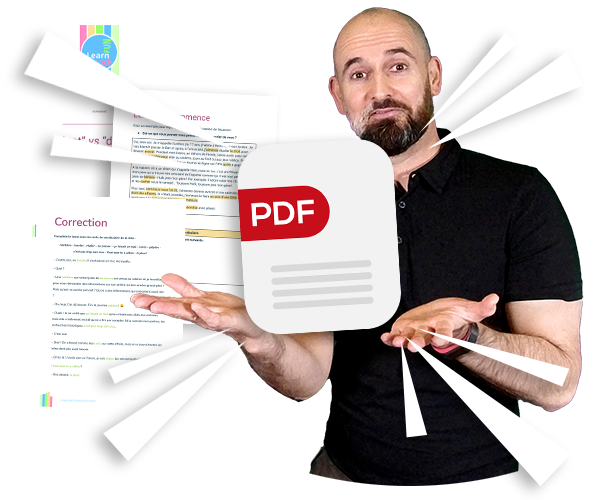When you’re learning a new language, it’s important to get a handle on all of the different verb tenses. In French, there are three different ways to say “to be”, and each one has a different meaning. Today, we’re going to learn about the difference between “c’est”, “il est”, and only “est”. By the end of this post, you’ll be an expert on when to use each one!
Ready to get started? Let’s go!

PDF Bonus
We have prepared a free PDF to help you understand and master the difference between “c’est”, “il est” and “est” in French.
👉 Download it for free
At the end, you will have exercises to practice with the correction. 👍
EST or C’EST ?
Let’s take an example:
- “Enseigner le français est fun.” (Teaching French is fun)
- “Enseigner le français, c’est fun.” (Teaching French is fun)
The 1st sentence is a classic sentence: a subject, a verb and a complement.
- Verb : is
- Subject: Teaching French (the action of teaching French)
- Complement: fun
In the 2nd sentence, the meaning remains the same, it’s still fun to teach French
Yes, it is 🙂
…but we’re going to insist, and to insist, we’re going to take up the subject, we’re going to use “this”.
Why? It’s a Gallicism, a particularity of the French language. You know the Gallic people who don’t want to do like everybody else !
Warning: in sentence #2 – “Enseigner le français, c’est fun.” – you need the comma. And so when speaking, to mark a small pause:
“Enseigner le français… [PAUSE]… c’est fun.”
Making the difference between “c’est” and the verb être all by itself – “est“, was easy.
Do you like learning French with videos?
Receive our free video newsletter every Friday in your e-mail box. You will get 3 “Tips & Tricks” on grammar, vocabulary, phonetics or French culture.
👉👉 Sign up now!
Let’s now look at the case of “c’est” vs “il est“.
So, things get a little more complicated…
First, here, the language level between the two is A1 (beginner).
For example, should we say, “C’est un médecin” or “il est un médecin” → We say, “C’est un médecin” (he is a doctor).
In this example, it’s easy! But if you want to be able to choose between all the rules involved, depending on the particular case of your sentence, depending on the many exceptions that exist, it’s C1 (expert) level.
And yes, because there are many different situations that require “c’est” or “il est“. And if you can ask yourself all the questions that lead to the solution, then that means you are C1. But a C1 doesn’t ask the question anymore…
So how do you do it?
You have the option of memorizing (like a script for theater) all the situations that exist for C’EST and IL EST, and then you can expect your brain to work like a quantum computer and allow you to choose the right answer very quickly.
This is another option.
I understand your reaction…
If you understand all the situations, you need to be C1 (expert) to make an A1 (beginner) sentence.
Or, you don’t understand anything but you learn all the situations and your brain has to work at the speed of light to make the right choice right away.
Thanks to the French language!
How do we do it, then???
I propose to simplify things.
You, you want to know when to use “c’est” or when to use “il est“.
I will propose you a method which will work in the majority of the cases, but not always! Remember C1 (expert) or learn everything by heart…
The solution to choose between “c’est” and “il est” in French
| C’est → Answer the questions: Who is? or What is this? Who is it/he/she? What is it? → Identification of an object or person. → Category of the object or person. . | Il est → Answer the questions: how / what is his/her profession, trade, work / what is her nationality? → For description. → Specific information about an object or person is given. |
Imagine you had to talk about this photo:

1st thing, you are going to give information about the category.
In which category can you put what we see in this picture?
- C’est un homme (It is a man)
- C’est un super héros (It is a superhero)
- C’est Captain America (It is Captain America) Note: when you know his name, you use “c’est”.
Then, when the main category is defined, you will give additional information, special characteristics of this object or person:
- Il est fort (he is strong),
- Il est bleu (he is blue),
- Il est musclé (he is muscular),
- Il est le défenseur du monde libre et du hamburger (he is the defender of the free world and the hamburger)
Let’s take another example:

Same method. First, the category with “c’est“, and then specific information about this object with “il est“:
- C’est quelque chose qu’on peut manger (It is something you can eat)
- c’est un sandwich (it is a sandwich)
- c’est un Pan Bagnat (it’s a Pan Bagnat, delicious speciality from Nice :D)
- c’est un sandwich (it is a sandwich)
We have just defined more and more precisely the category of this object. We used “c’est”. But we’re still in the category.
- A very general category → It’s something you can eat
- A more precise category → It’s a sandwich
- An even more specific category → It’s a Pan Bagnat
Now we’ll give specific information about the object we see – which is part of the category already determined:
- il est coloré (it is colorful),
- il est appétissant (it is appetizing – we want to eat it),
- il est gros (it is big),
- etc
C’est or il est?
- “c’est” for the category or name.
- “il est” to give specific information about that element of the category.
The implication is that you can choose whether you decide to talk about the category or the specific feature.

| CATEGORY C’est un président des Etats-Unis (This is a president of the United States). → The person in the picture is in the category of President of the United States. | SPECIFIC INFO Il est président des Etats-Unis. He is president of the United States (or rather, he was…) . |
You decided to choose to talk about the category → “c’est” (it’s)
You decided to talk about Donald’s specific info → “il est” (he’s)
Note : you noticed that with the profession :
c’est + article + métier → c’est un président
il est + métier (il n’y a pas d’article) → il est président
So remember, we simplified and most importantly, we didn’t see the many special cases. The purpose of this post is to give you a solution for the most frequent situations, which happen most often.
It is to allow you to choose between “c’est” and “il est”.
Conclusion
So there you have it! A few simple tips to help you remember when to use “c’est”, “il est” and just “est”. Of course, if you’re ever in doubt, it’s always best to check with a native speaker. But with these guidelines in mind, you should be able to produce the correct form of this pesky verb every time.
À bientôt et bonne chance dans tes études de français !
Articles that might interest you:
- The Imperative in French: How to Conjugate Verbs in Imperative? When do You Have to Use the Imperative?
- The 10 Irregular Verbs in the French Subjunctive Mood
- Depuis, pendant, en, il y a, dans
- All the secrets of the French gerund!
- French verb moods
- How to use the tonic pronouns in French?
- How to use “en” and “y” pronoun in French?
- Difference between DONT and DUQUEL in French
- 10 common French verbs conjugated in the present tense. Beware of traps!
- The Direct Object Complement in French (C.O.D.) and direct complement pronouns (le, la, les…)




1 thought on “What is the difference in French between “c’est”, “il est” and only “est”?”
Comments are closed.